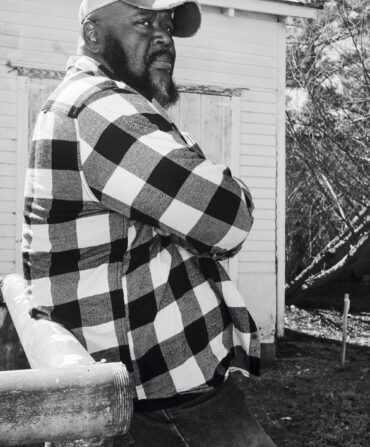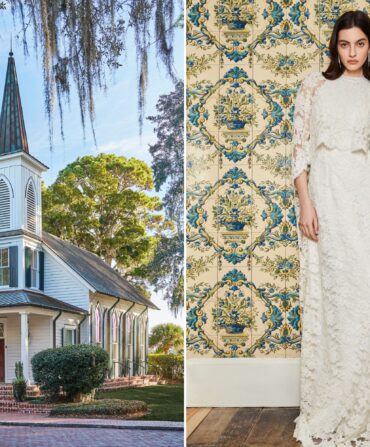Arts & Culture
William Faulkner’s Hollywood Odyssey
The biggest name in Southern lit didn’t spend his whole life in Mississippi
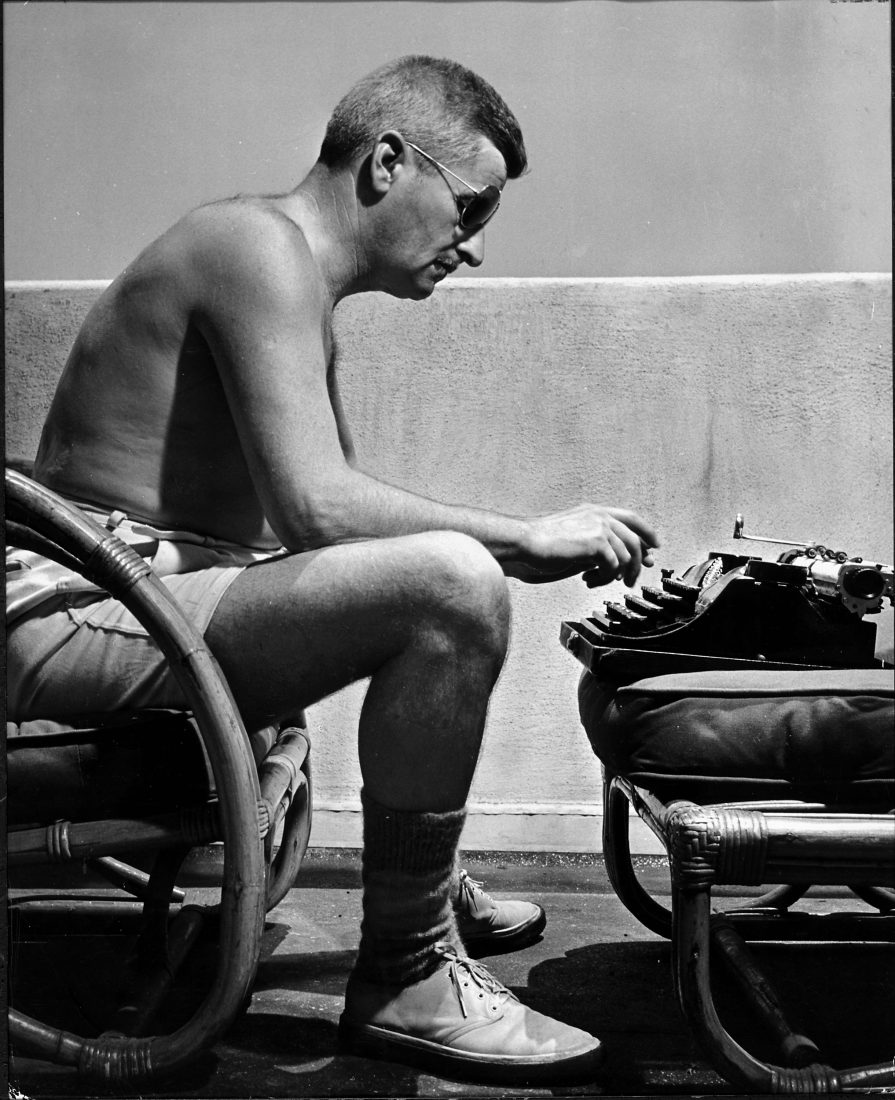
Photo: Photo by Alfred Eriss/Pix Inc./Time & Life Pictures/Getty Images
In 1932, a rising writer from Mississippi found himself amid the bright lights and dry heat of Tinseltown, at the start of what would become a lengthy dalliance with the screenwriting biz. In the wilds of L.A., William Faulkner met movie stars, found a bourbon haunt, chased true love, and tried to stay sane in a place that often seemed very far from home.
“We heard that he was coming.” That was what the head stenographer at Warner Bros. said, recalling the day the author William Faulkner set foot on the studio lot in 1942. Here was the most famous resident of Oxford, Mississippi (population 5,000), in—of all places—Tinseltown. The tweed and pipe just seemed out of place with the neon and palm trees.
But although Faulkner will forever be identified with his life among the cedars in Oxford—a man “deeply, almost mystically attached to the land,” as Time memorialized him in 1964, complete with a Delta lilt—his years as a screenwriter in Hollywood were not a mere hiccup in his biography. For it was here, working off and on for two decades in an industry that Faulkner once said was “too much for anybody raised in Mississippi to see all at once,” that he had two major affairs. One was professional—he courted a relationship with one of the most prestigious directors in the most glamorous business on earth. The other was personal—a transformative romance with a beautiful script supervisor who called him the love of her life.
Like Faulkner, I grew up in the South and moved to Los Angeles in my thirties. I had to adjust to this place of the endless summer without humidity, where people think the way to sweeten iced tea is with Equal. I was curious what L.A. must have been like for the twentieth century’s quintessential Southerner, a man whose great-grandfather fought for the Confederacy. Here he was, almost two thousand miles away from home, in a place he described as “the plastic asshole of the world.”
* * *
There have long been famous authors who did their turns in Hollywood (Didion and Dunne, Capote, Fitzgerald), but Faulkner especially seemed to have a gift for film. As fellow novelist turned screenwriter Stephen Longstreet observed, Faulkner was “one of the few real geniuses who ever wrote for the movies.” He was so skilled, in fact, that he adapted the work of two other major novelists, Raymond Chandler and Ernest Hemingway, who also tried their hands at screenwriting.
It all started in 1932, when, riding on the success of his novel Sanctuary, Faulkner got word that Leland Hayward, a prominent Hollywood talent agent, had secured for him a $500-a-week contract (the equivalent of $8,500 today) to write scripts at Metro-Goldwyn-Mayer. Faulkner was a modernist, and film was still a new, exciting form of storytelling. But that wasn’t the reason Faulkner accepted. It was the money.
At the same time Faulkner received the offer from Metro, he got news that his publisher, Cape & Smith, was bankrupt. Faulkner had been planning on $4,000 ($68,000 in today’s money) from the company for Sanctuary but was informed he wouldn’t see any of it. Suddenly, he was broke. Word apparently got around Oxford. When he tried writing a check for three dollars at a sporting goods store, the owner told him, I’d rather have cash. All at once, Hollywood became attractive. Faulkner didn’t even have the money to send a wire to answer yes. Eventually MGM advanced him some cash and paid for his train ticket, and days later he arrived in Culver City.
He was so naive about the industry that he entertained hopes he would be writing for the famous movie star Mickey Mouse. But the folks at Metro informed him, No, Mickey lives at another studio out in the Valley—we want you for a Wallace Beery picture. “Who’s he?” Faulkner asked. The more he learned, the more frightened he became. “The truth is that I was scared,” Faulkner disclosed in an interview with the Los Angeles Times. “I was scared by the hullabaloo over my arrival, and when they took me into a projection room to see a picture, and kept assuring me that it was going to be very easy, I got flustered. I was afraid I could never do it. I could think of nothing else to do but run.” He sought refuge in Death Valley—“It was the quietest place that I could think of,” he said—and after a week of regrouping returned to the studio, ready to write.
Faulkner completed four story treatments in four weeks. That kind of productivity earned him a meeting with up-and-coming director Howard Hawks. He liked Faulkner’s writing and purchased a Saturday Evening Post short story by him that he wanted Faulkner to adapt into a script for Hawks to direct. Over a “couple of quarts of whiskey,” as Hawks recalled in an interview, they clicked and found common cause. “[Faulkner] got up the next morning and started to work, and in five or six days, he had a script,” Hawks said. “It was one of the finest scripts I’ve ever read.” Hawks showed it to Metro’s head of production, Irving Thalberg, who concurred. “Go out and make it!” he ordered Hawks. The result was Today We Live, a drama starring Gary Cooper and Joan Crawford, released in 1933. William Faulkner now had a hit movie to his credit. And, more important, the beginning of what would become an ongoing professional connection with Hawks.
* * *
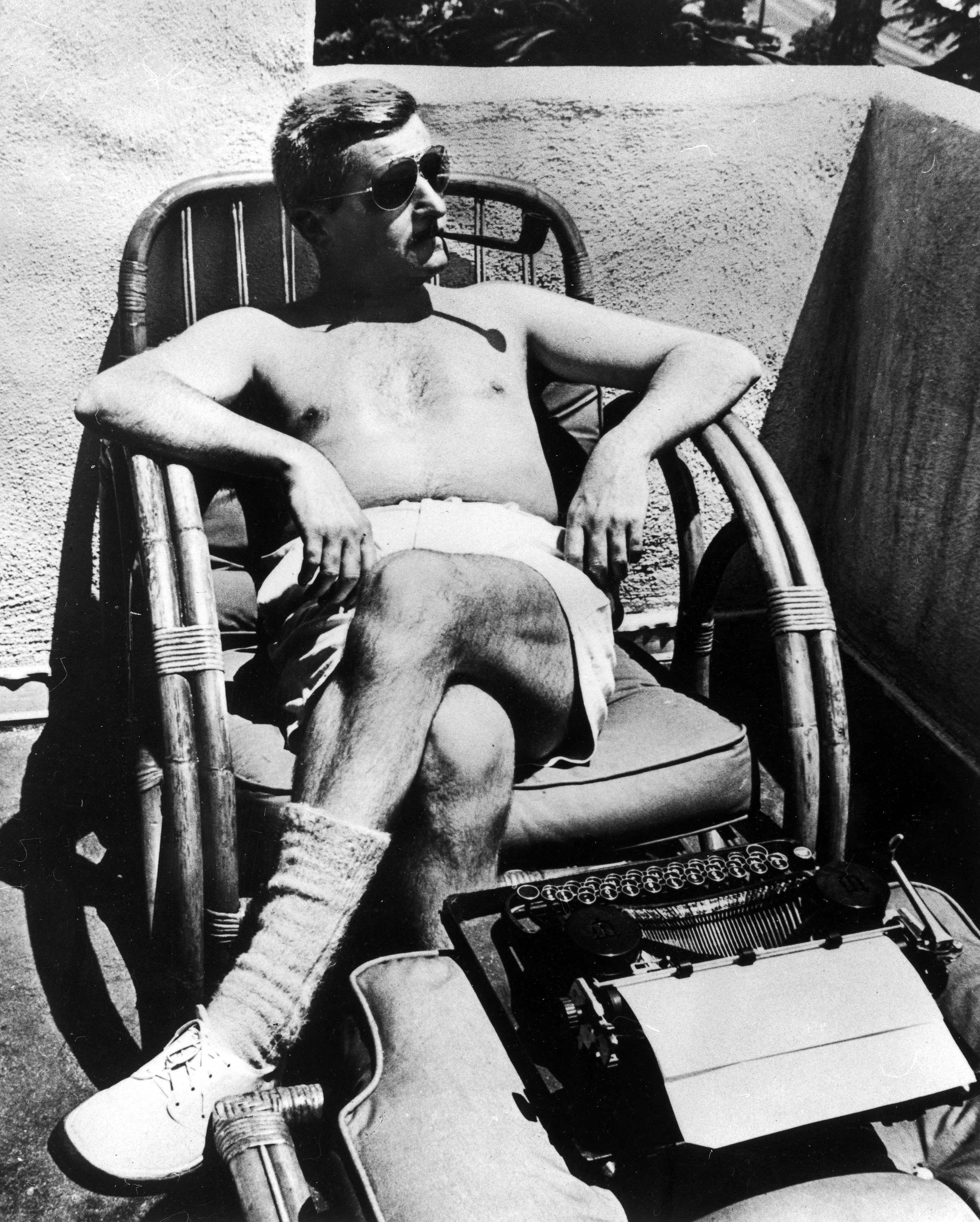
Photo: Photo by Alfred Eriss/Pix Inc./Time & Life Pictures/Getty Images
Faulkner soaks up some sun.
“Abandon hope, all ye who enter here.” The quotation from Dante is what Faulkner considered a fitting road sign for drivers to see as they crossed the border into California. (For Arizona, his thought was “Science Fiction Country.”) It was a telling description of how he viewed his new home away from home. For good reason, it’s often said that when people move to Hollywood, they’re likely to lose their true identity, heritage, and sense of purpose—this is La-La Land, after all. But Faulkner didn’t. He had his pipe and tobacco, and his bourbon, and he could still hunt.
Back home in Mississippi, Faulkner helped incorporate the Okatoba Hunting and Fishing Club, which is to say that he was adept at handling more than just a fountain pen. In fact, Faulkner’s biographer Joseph Blotner said the novelist didn’t really like to talk about literature at all. His favorite subjects were horses, dogs, hunting, and flying. When reporters caught him on his way to Sweden to accept the Nobel Prize, they asked him about literature. “I don’t subscribe to the literary magazines,” he replied. “The magazines I read deal with horses and cattle and hunting.”
It’s hard to imagine now, but back when Faulkner was young, a block or two north of Ventura Boulevard in the San Fernando Valley was all orange groves. Southern California was a strange land, the desert next to the ocean. One could say, as Faulkner did shortly after arriving here, “I’m goin’ pig huntin’,” and spend the day on Santa Cruz Island stalking wild boar. After the excursion, he returned to the Beverly Hills Hotel “unshaven, clad in his hunting shirt, and carrying a borrowed weapon under his arm,” as producer David Hempstead recalled in an interview. When Faulkner walked through the lobby, he sent guests and the hotel staff scurrying for cover. Earlier, there had been an armed robbery, and everyone thought Faulkner was the perpetrator returning to the scene of his crime.
Faulkner sometimes hunted with Hawks, and on one dove hunting trip recounted by the director, Hawks invited along Clark Gable, already a star. Faulkner and Hawks began discussing literature and eventually Gable asked, “Mr. Faulkner, what do you think somebody should read if he wants to read the best modern books? Who would you say are the best living writers?” Faulkner replied, “Thomas Mann, Willa Cather, John Dos Passos, Ernest Hemingway, and myself.” Gable asked, “Oh, do you write, Mr. Faulkner?” Faulkner replied, “Yeah. What do you do, Mr. Gable?”

Photo: Meta Carpenter Wilde Collection, The University of Mississippi
Faulkner and Meta Carpenter at her apartment building.
* * *
One of my favorite places in Hollywood is the Musso & Frank Grill. From the outside the restaurant is unassuming—just another establishment on Hollywood Boulevard, tucked in among souvenir shops, tattoo parlors, and trashy lingerie stores. But the inside is like a time machine, transporting you back to an era when men wore fedoras, and red leather booths and wood paneling marked the height of sophistication. The waiters, in black bow ties and red jackets, look like they’ve worked there since Musso opened its doors in 1919. In a town where a restaurant that survives five years is an “institution,” Musso & Frank is an anomaly. It has always been a favorite of writers, as well. A few years ago, I saw Gore Vidal there and he told me he considered Musso to be “the only restaurant in Los Angeles.”
It certainly became part of Faulkner’s routine. In the depths of World War II, he wrote to his daughter, Jill, from his hotel apartment on Highland Avenue a few blocks from Musso & Frank. “It used to be that a Negro waiter in the hotel here brought my breakfast up to my room,” he reported. “But since rationing started, and men got good jobs in aircraft plants, they have closed the dining-room. So I get up at seven, bathe and shave and dress, and walk down to Musso-Frank restaurant and buy a paper and have orange juice, toast, marmalade and sometimes little fellows [sausages].” He would also retreat there in the evenings to unwind at the bar, sometimes with other writers (Faulkner ordered Old Grand-Dad bourbon). And it was here that he first dined with the woman he would love for the rest of his life. Her name was Meta Carpenter.
A ninety-two-pound blonde who grew up in Tunica, Mississippi— about an hour and a half’s drive from Oxford—Carpenter worked as Howard Hawks’s secretary. On the day Faulkner met her, in 1935, he asked her to join him for supper. She knew he was a married man—he was, as she noted, “the William Faulkner”—and at first resisted. But he kept after her, and she gave in. At first, it was just for suppers. After a few dates at Musso & Frank, theirs became a torrid affair. “I have to see you every night,” he told her. But it was not the glamorous Hollywood tryst that one might imagine. Faulkner sent most of the money he was earning back to Mississippi to pay for expenses at his home, Rowan Oak. It was being held down by his wife, Estelle, an alcoholic—disgraceful for a woman of the South at the time—who had no respect for his work. “She has always looked on it as a hobby, like collecting stamps,” he said.
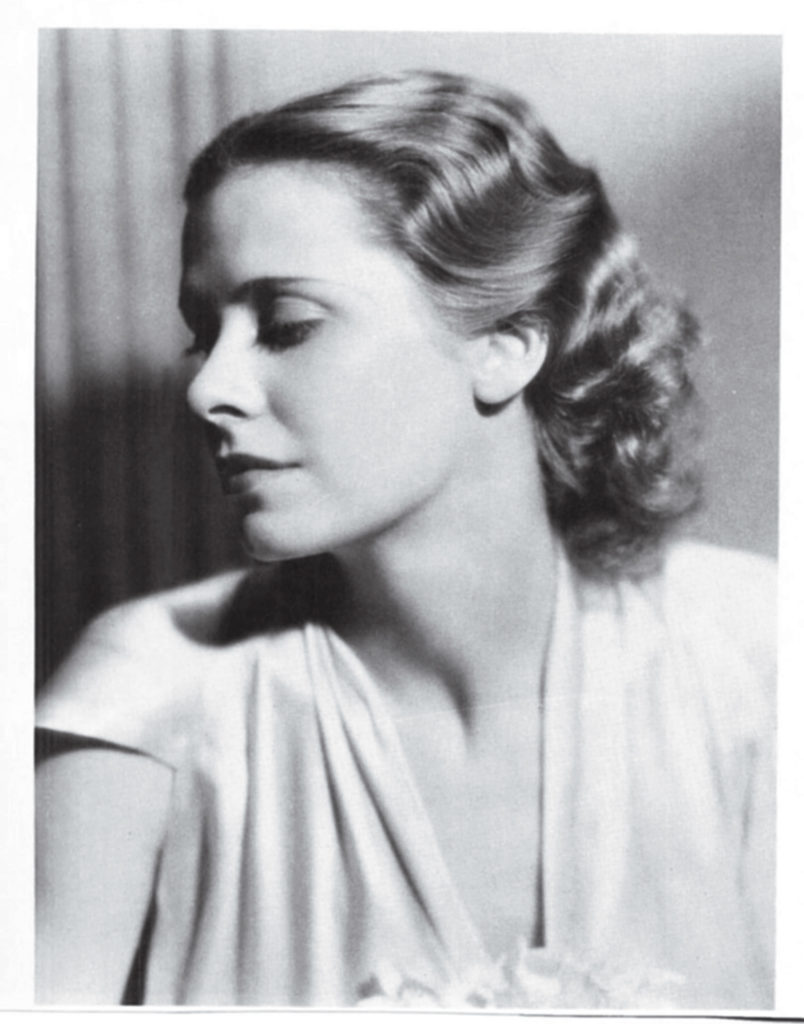
Photo: Meta Carpenter Wilde Collection, The University of Mississippi
A portrait Carpenter had made for Faulkner.
On Faulkner’s dates with Carpenter, their funds were so limited that going to the movies was a luxury, she recalled in her 1976 memoir. So many of their outings consisted of modest activities: Ping-Pong in the game room of Carpenter’s apartment building, putt-putt in the morning before work. On weekends, they would head to the beach, where they dined on hot dogs and drank sodas. One evening after supper as they strolled along Hollywood Boulevard, they dipped into a bookstore because Faulkner wanted to purchase his book of poetry, A Green Bough, for her. He asked the clerk if they had any additional William Faulkner books. No, he replied, Faulkner doesn’t sell well, and most of his stuff is out of print anyway.
Despite the strains, these were halcyon days in California for Faulkner—“golden yellow with sunlight,” as Carpenter remembered. I located the address where she lived when they were first dating and went there to look around. At the corner of Lodi Place and Lexington Avenue in Hollywood is a light pink three-story stucco building, surely once majestic, but the years have taken their toll. It’s now a headquarters for the Los Angeles Job Corps Center operated by the YWCA, and is curiously empty. Three teenagers were sitting on the front steps smoking pot. The front doors were locked, but I peered in the window. I could see what at one time was the lobby reception desk, where the night watchman would let Carpenter in after a late night with Faulkner. In a different time, I thought, this is where Faulkner once told Carpenter, “You save my damned life out here, Meta. I swear you do. You keep me alive and sane.”
* * *
By 1936, Faulkner was hitting his stride professionally. In fact, whenever Howard Hawks had a problem with a movie, he would ring the author: I’m stuck. Faulkner knew just how to fix things. His latest assignment was to help write the screenplay for Gunga Din for RKO, and he was falling more deeply in love with Carpenter. But sometimes a disquiet seemed to move in on him like fog. On dates with Carpenter, there would be long silences. He would stare off into space. Faulkner’s mind was back home in Oxford. His wife was giving so much of their money to her parents—the same people who had rejected Faulkner as a suitor for their daughter—that eventually he was compelled to take out an ad in Southern papers to prevent any further debt in his name: “I will not be responsible for any debt incurred or bills made, or notes or checks signed by Mrs. William Faulkner or Mrs. Estelle Oldham Faulkner,” read the announcement that appeared in the Memphis Commercial Appeal and the Oxford Eagle.
The step he took a month later would put his romantic life at a challenging crossroads: To keep tabs on Estelle and his only child, Jill, he moved them from Mississippi to a house in the Pacific Palisades neighborhood of L.A. (Once they got acquainted, Clark Gable would stop by on occasion; Ronald Colman was another regular.) The move would lead to an evening that caused at least one biographer to accuse Faulkner of being a sadist.
One day, he summoned Carpenter for lunch at the studio. “On Thursday night I want you to come to the house for dinner,” he announced. He had a plan: Carpenter would attend with Faulkner’s friend Ben Wasson and pretend to be Wasson’s romantic partner. Faulkner said that he’d already announced to Estelle that they would be entertaining guests—“all she knows is that you’re from the South and a friend of Ben’s.” Carpenter went along with the idea. “I could trust him,” she said.
From the start, it was dicey. Estelle seemed curious. “Billy tells me you’re from the Delta,” she said, upon meeting Carpenter. “What a small world we live in.” Carpenter tried to keep from looking Faulkner in the eye. The more everyone struggled to make conversation, the more liquor flowed. At one point, when Estelle poured herself a fresh drink, Faulkner tried to take her hand off of the glass in clear sight of everyone. Estelle rebuked him: Billy, don’t. The next day, according to several sources, Estelle was outraged. Call it women’s intuition or what have you; she was wise to her husband’s ruse.
I found the house that the Faulkners rented in the Palisades and tried to visualize the dinner party. Had the Hollywood penchant to elevate fantasy over reality finally caught up with him? I called on Robert Hamblin, assistant director of the Center for Faulkner Studies, to help me understand that night. “Faulkner was an egotist,” Hamblin explained, “and he seldom worried about other people’s opinions or viewpoints, which is highly ironic, since one of the hallmarks of his fiction is his ability to look at an event from multiple perspectives. I’m guessing his motivation for inviting Meta was simply for his own personal pleasure. I don’t think it was consciously done to hurt Estelle. But of course she had a different take on the situation.” Years later, Carpenter said she regretted participating in the charade. She regarded it as an “invasion” of Estelle’s house, and felt ashamed.
Faulkner thought that having his wife and daughter in L.A. would help matters, but it seems just to have stirred up more strife. Joseph Blotner reports that when a coworker saw an injury on Faulkner’s forehead and asked what caused it, Faulkner replied, “I was just sitting there reading Time magazine when Estelle came at me with a croquet mallet.” Before long, Estelle and little Jill were back in Mississippi.
* * *
“I am writing a big picture now, for Mr. Howard Hawks, an old friend, a director. It is to be a big one. It will last about 3 hours, and the studio has allowed Mr. Hawks 3 and ½ million dollars to make it, with 3 or 4 directors and about all the big stars. It will probably be named ‘Battle Cry.’”
In the spring of 1943, Faulkner posted a letter to Oxford. It was a report addressed to Jill and outlined his most ambitious undertaking to date: a unique war picture that would capture the upheaval the world was undergoing, a drama that would give voice and emotion to the Allied forces in World War II, “a defense of liberty all over the world,” as studio notes describe it.
I first saw the documents for Battle Cry in the Warner Bros. Archives, part of the University of Southern
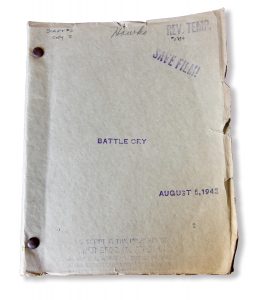
Photo: Amy Dickerson
A draft of Faulkner’s unproduced script, now housed in the Warner Bros. Archives.
California’s School of Cinematic Arts, located just south of downtown L.A. Instead of being housed on the main campus, this collection is so large it’s on the other side of a freeway in an annex. Once buzzed in, I walked past rows and rows of bankers’ boxes on shelves. They contain scripts, studio memoranda, letters, telegrams, and close to 400,000 photographs, according to the archives director, Sandra Garcia-Myers.
The Faulkner files were waiting for me. There was his contract, signed in fountain pen. When I went deeper, I discovered that for Battle Cry, Hawks had assigned Faulkner to merge short stories, a radio drama, and even a musical cantata into one screenplay. The two had come a long way since their first collaboration on Today We Live back in the 1930s. Hawks was now formidable, with such hits as Scarface, Bringing Up Baby, His Girl Friday, and Sergeant York under his belt. Faulkner, too, was on his way up to the pantheon, having published The Unvanquished, The Wild Palms, The Hamlet, and Go Down, Moses and Other Stories since first coming to Hollywood. To work on Battle Cry, Faulkner left with Hawks and went to June Lake in the Sierra Nevada mountains to begin writing (and fishing and drinking). Two weeks later, Faulkner had 143 pages of a treatment. By the end of July, he had written an entire script.
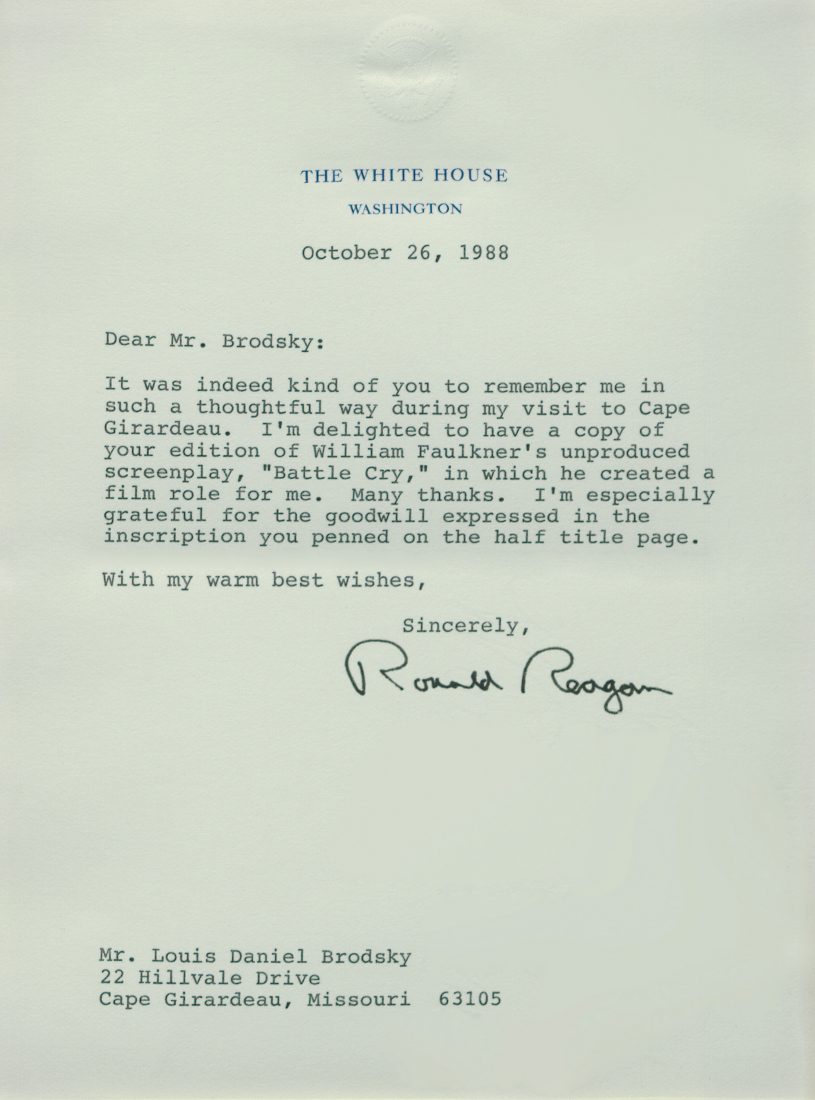
Photo: Courtesy of Faulkner Studies, Southeast Missouri State University
A letter from President Reagan to scholar Daniel Brodsky after he received a copy of Battle Cry.
As I paged through the script, I saw scenes in Paris, on the beaches of Dunkerque, France, and in Springfield, Illinois (for a sequence paying tribute to Abraham Lincoln). Two characters were called Fonda and Reagan. I’d find out later this reflected the writers’ practice of inserting the names of actors they imagined would best play the parts. Faulkner envisioned Battle Cry as an epic starring Henry Fonda and Ronald Reagan, then a movie star under contract at Warner Bros. (In 1945, Faulkner adapted Stephen Longstreet’s novel Stallion Road into a screenplay. The studio cast Reagan as the star and released the picture in 1947.)
I discovered that Faulkner’s upward trajectory peaked with an offer to work exclusively with Hawks in their own independent filmmaking unit. “He and I had a talk at the fishing camp…. I am to be his writer,” Faulkner wrote to Estelle in 1943. “He says he and I together as a team will always be worth two million dollars at least.” It was an outstanding plan, one that would appeal to filmmakers even today. Faulkner wrote, “We can count on getting at least two million from any studio with which to make any picture we cook up, we to make the picture with the two million dollars and divide the profits from it. When I come home, I intend to have Hawks completely satisfied with this job, as well as the studio. If I can do that, I won’t have to worry again about going broke temporarily…. This is my chance.”
The dream of a lifetime. One that would have launched Faulkner and Hawks into the Hollywood stratosphere. But it was never to be. Hawks had a reputation for going over budget on his pictures, which meant that the $4 million required to produce Battle Cry ($53.8 million in today’s money) would surely mean more…and more…and more. The studio said no. Faulkner’s romantic dream of filmmaking had come to an end. He would continue to do work for Hawks, including writing screenplays for Hemingway’s To Have and Have Not and Chandler’s The Big Sleep, both of which became films starring Bogart and Bacall. To an outsider, those classics might seem like the pinnacle of a career. For Faulkner, they were little more than paychecks, not the imaginative, unique film projects he and Hawks had once dreamed of making on those summer nights up at June Lake.
* * *
For the rest of Faulkner’s life, he and Carpenter continued to correspond and sometimes talk, but despite repeated promises to leave his wife and marry his lover once his daughter was grown, Faulkner couldn’t escape a Southern sense of loyalty. And so both of his Hollywood “affairs” ended unfulfilled. He could never bring himself to leave his family for Carpenter and build the life they imagined, and he never achieved the great success he sought with Hawks.
Of course, it’s hard to cast the remainder of Faulkner’s life as a failure. If his life were a movie, the third act would represent a triumph of legendary proportions—a writer emerges from a career in screenwriting seemingly defeated, only to win the biggest literary prize of all and become a giant, not to mention having his own books adapted for the screen. One year before he was awarded the Nobel in 1950, MGM released his novel Intruder in the Dust as a movie. It was filmed in Oxford. The studio even held the world premiere there.
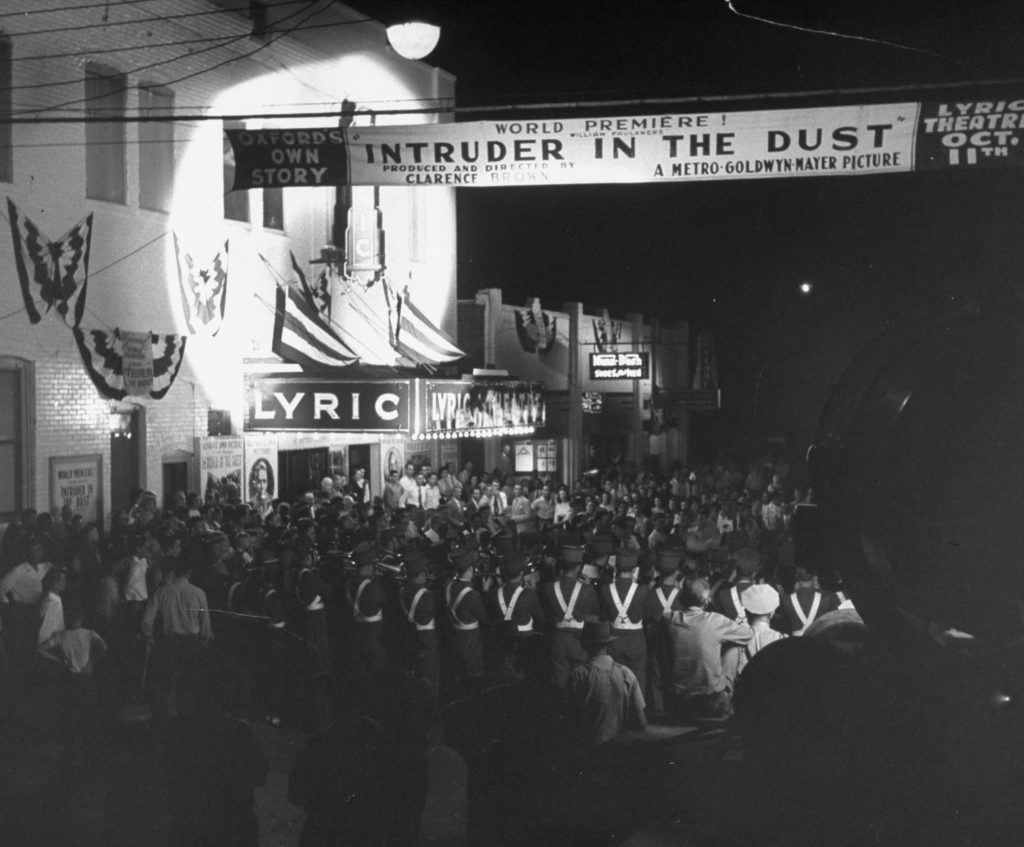
Photo: Photo by John Dominis/Time & Life Pictures/Getty Images
The 1949 premiere of Intruder in the Dust, based on Faulkner’s novel and held in Oxford, Mississippi.
Twenty-six years after Faulkner’s death, as Ronald Reagan was winding down his presidency, a Faulkner scholar and collector named Daniel Brodsky presented Reagan with a copy of the Battle Cry screenplay in a private meeting, never publicized. Here was the most powerful man in the world being handed a script written by the most significant figure in American literature. It had been more than four decades since Faulkner and Reagan crossed paths at the same studio in the Valley. “I didn’t know Bill Faulkner ever wrote a movie for me,” Reagan said.
One afternoon last fall, I went to the building where Faulkner lived when he was romancing Meta Carpenter and toiling away on Battle Cry. I met one of the tenants, Jeff Yanero, a musician who moved in thirteen years ago. He told me that when he first arrived from New York, he saw the building and the lights on in the penthouse and dreamed of living up there but was informed by the manager, Forget it, the penthouse tenants stay forever. So he took an apartment on the third floor and waited. Finally, the penthouse opened up, and he now lives where he once dreamed he wanted to be. I told him that William Faulkner once lived there, too—that’s where Life photographed him, bare chested, in shorts and sunglasses, doing his Hollywood thing. Yanero had no idea. He showed me around. We looked at Faulkner’s patio and contemplated the past. With Faulkner, it’s always the past.
Following my visit, Yanero ordered Faulkner’s novels. All the bookstores in Hollywood now have copies.



